Letters from Arthur Seaforth Blackburn to his family, 1941 - Part 12
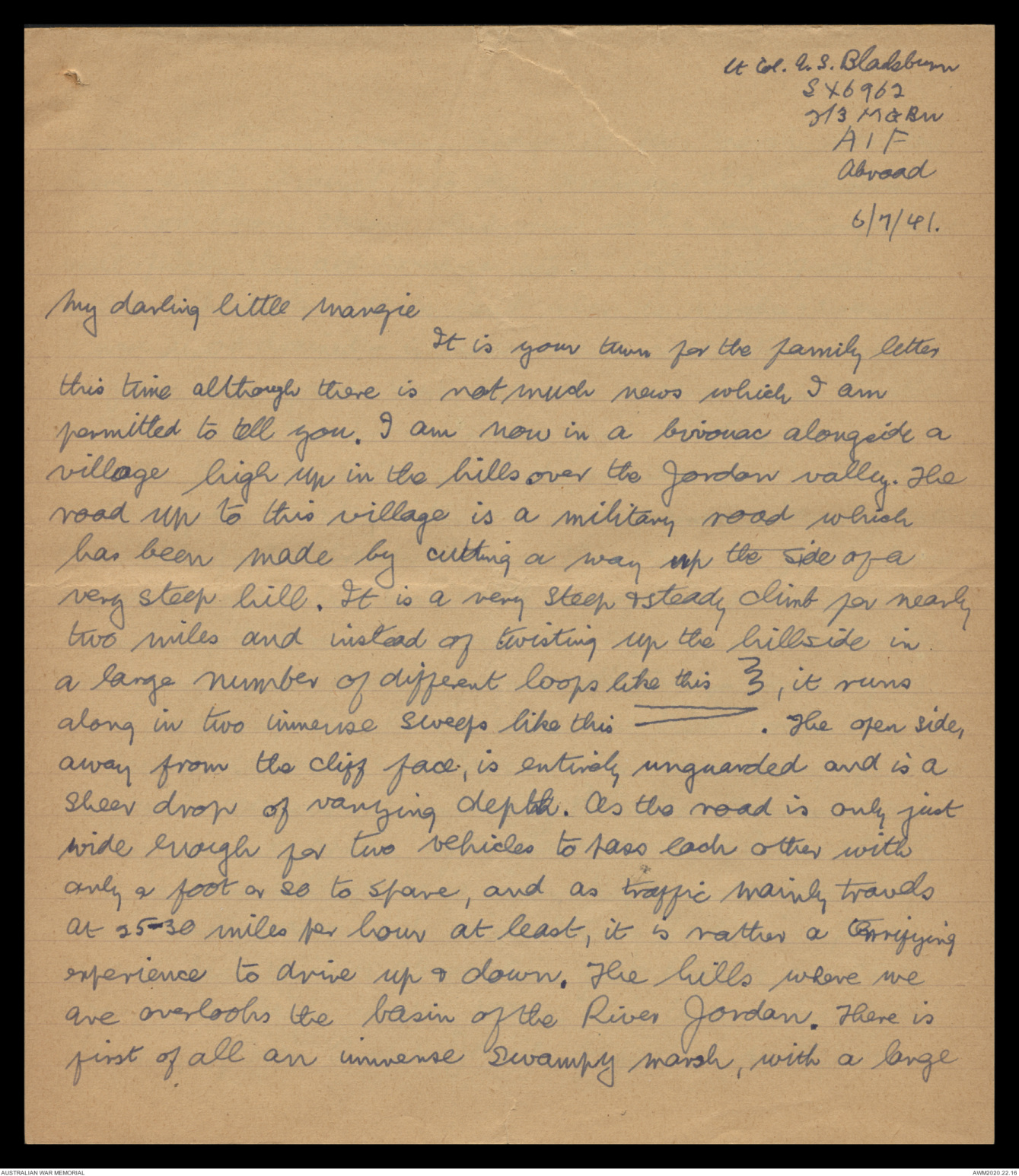
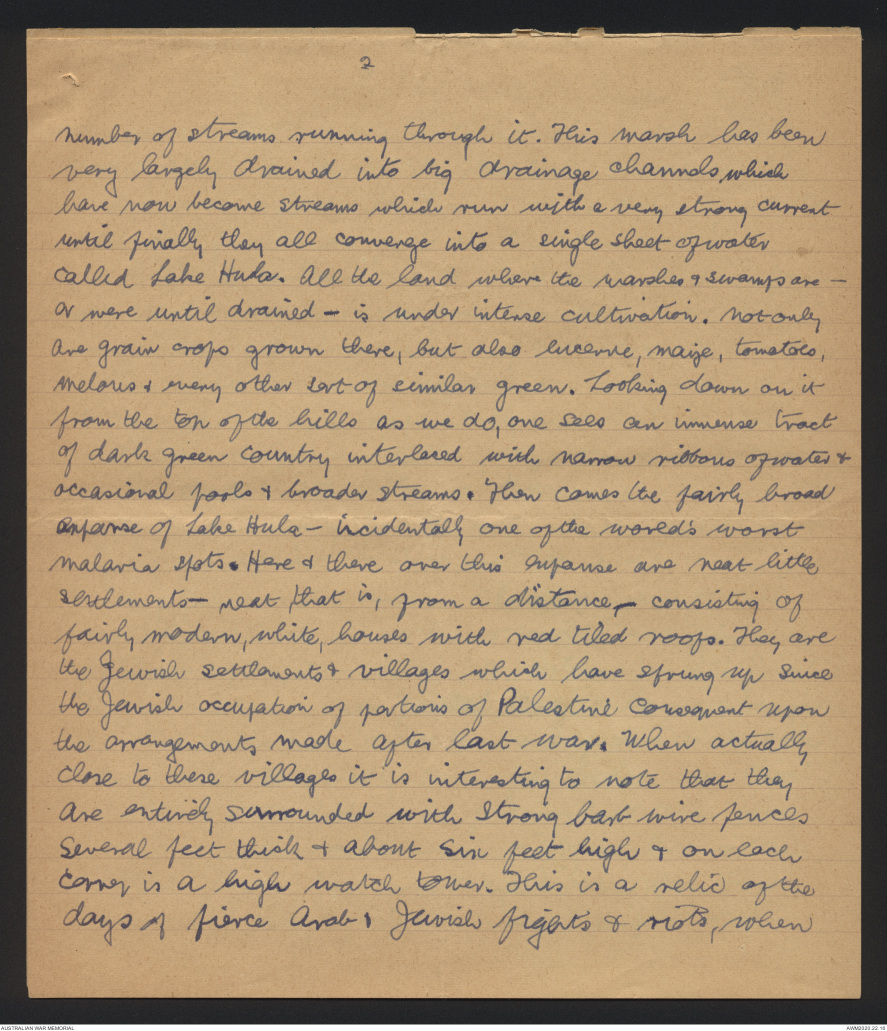
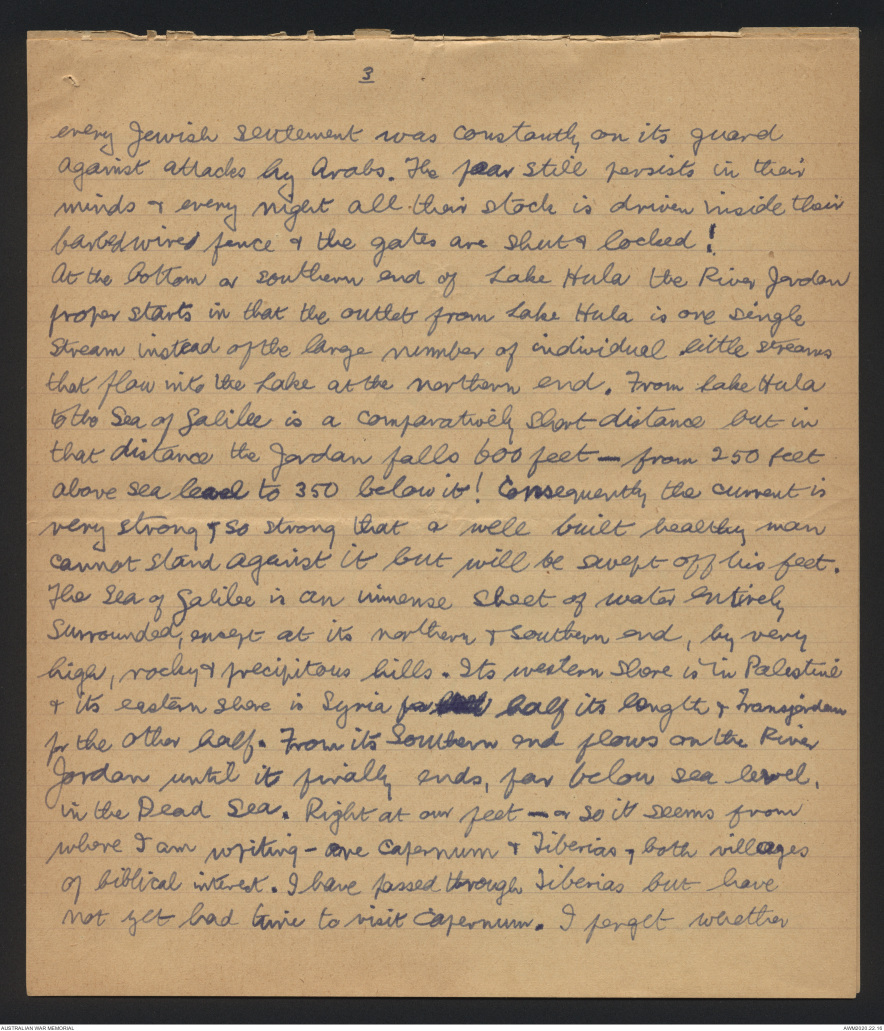
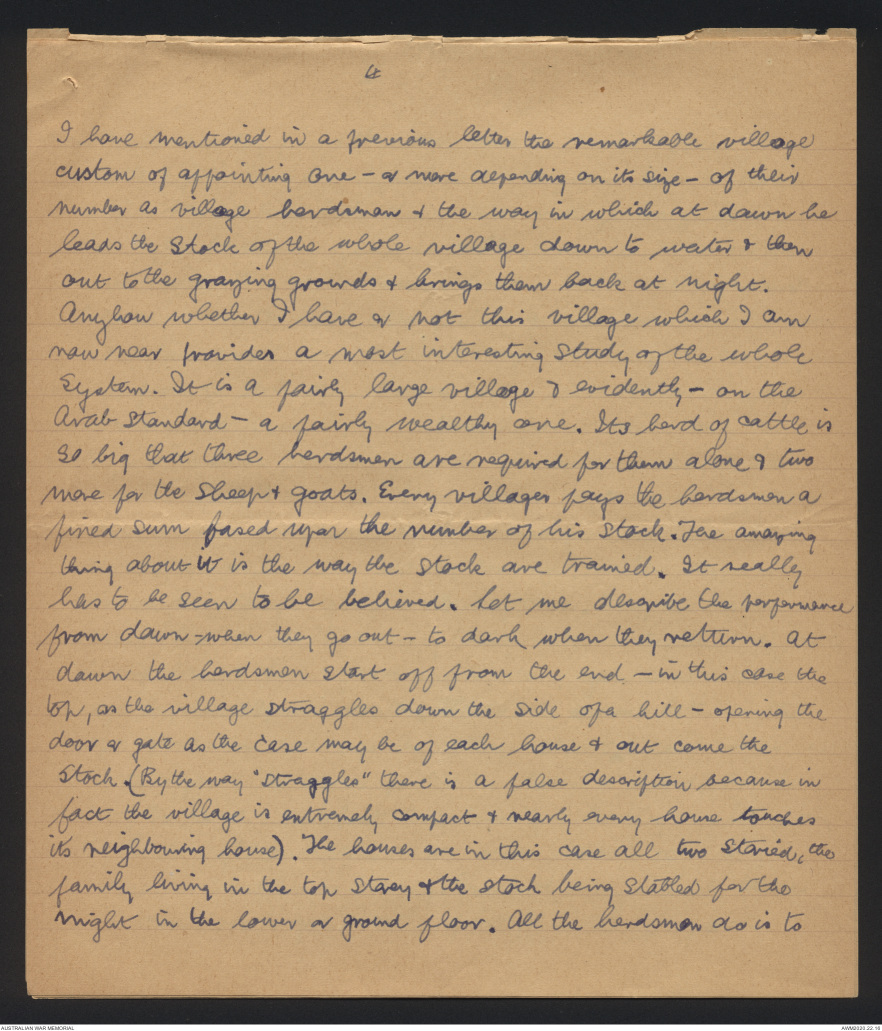
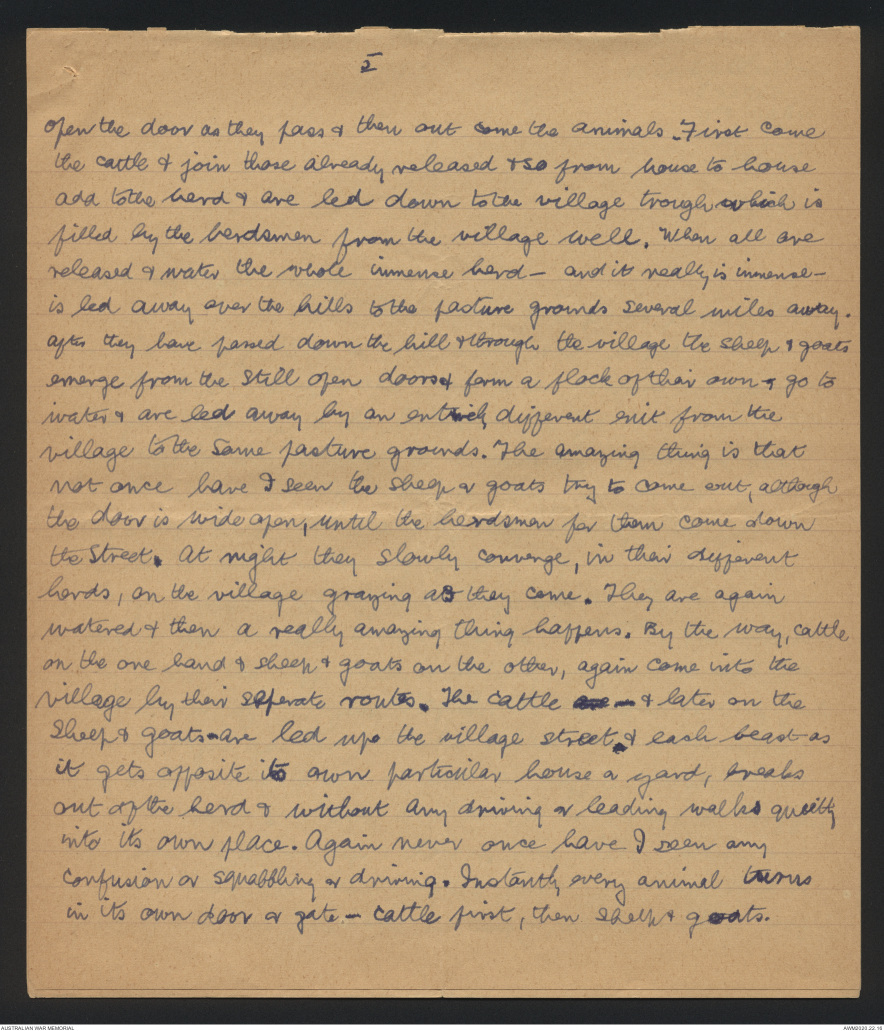
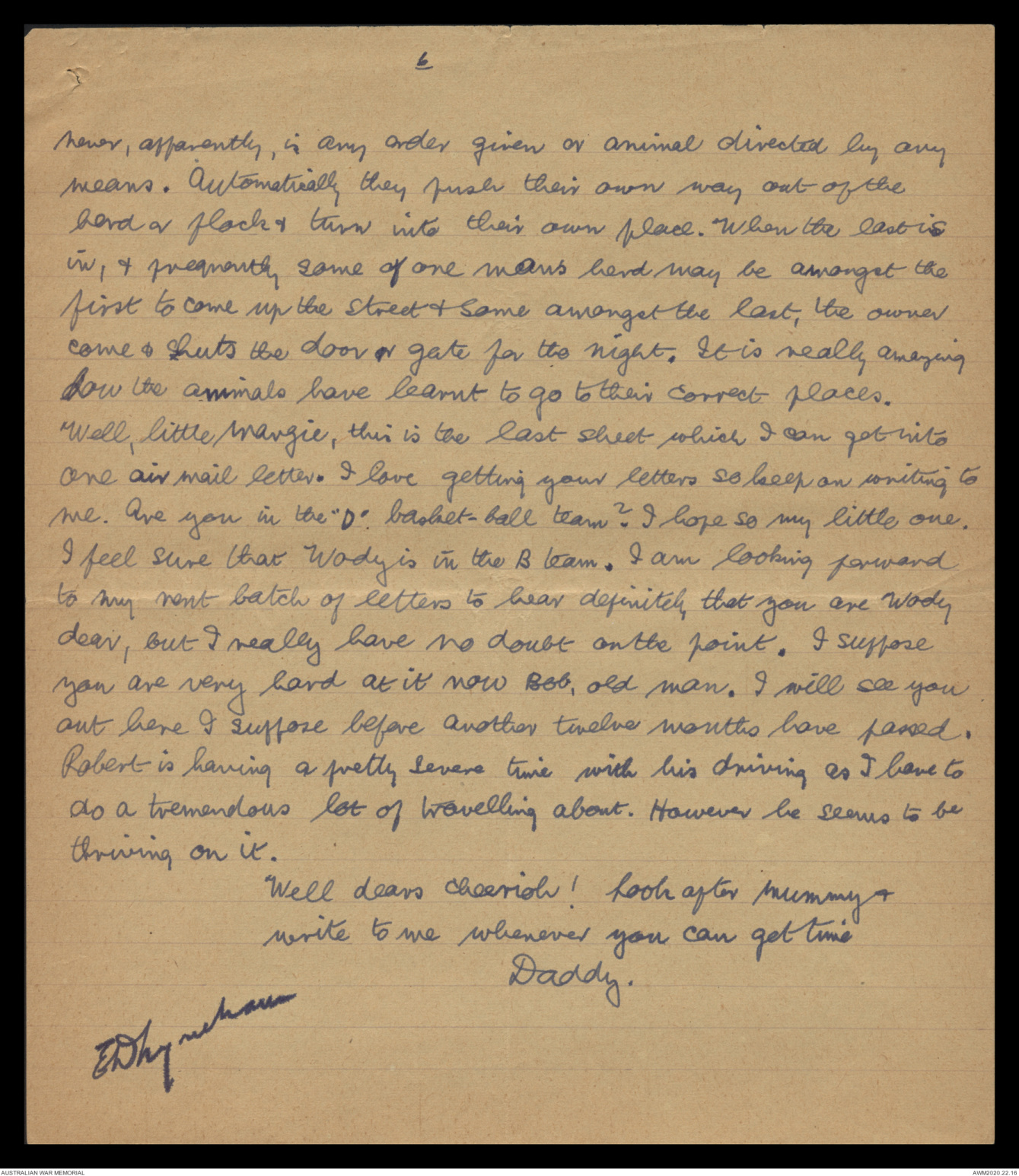
Lt Col. A.S. Blackburn
SX6962
2/3 MG Bn
AIF
Abroad
6/7/41.
My darling little Margie
It is your turn for the family letter
this time although there is not much news which I am
permitted to tell you. I am now in a bivouac alongside a
village high up in the hills over the Jordan valley. The
road up to the village is a military road which
has been made by cutting a way up the side of a
very steep hill. It is a very steep & steady climb for nearly
two miles and instead of twisting up the hillside in
a large number of different loops like this (diagram), it runs
along in two immense sweeps like this (diagram). The open side,
away from the cliff face, is entirely unguarded and is a
sheer drop of varying depth. As the road is only just
wide enough for two vehicles to pass each other with
only a foot or so to spare, and as traffic mainly travels
at 25-30 miles per hour at least, it is rather a terrifying
experience to drive up & down. The hills where we
are overlooks the basin of the River Jordan. There is
first of all an immense swampy marsh, with a large
2
number of streams running through it. This marsh has been
very largely drained into big drainage channels which
have now become streams which run with a very strong current
until finally they all converge into a single sheet of water
called Lake Hula. All the land where the marshes & swaps are -
or were until drained - is under intense cultivation. Not only
are grain crops grown there, but also lucerne, maize, tomatoes,
melons & every other sort of similar green. Looking down on it
from the top of the hills as we do, one sees an immense tract
of dark green country interlaced with narrow ribbons of water &
occasional pools & broader streams. Then comes the fairly broad
expanse of Lake Hula - incidentally one of the world's worst
malaria spots. Here & there over this expanse are neat little
settlements - neat that is, from a distance - consisting of
fairly modern, white, houses with red tiled roofs. They are
the Jewish settlements & villages which have sprung up since
the Jewish occupation of portions of Palestine consequent upon
the arrangements made after last war. When actually
close to these villages it is interesting to note that they
are entirely surrounded with strong barb wire fences
several feet thick & about six feet high & on each
corner is a high watch tower. This is a relic of the
days of fierce Arab & Jewish fights & riots, when
3/
every Jewish settlement was constantly on its guard
against attacks by Arabs. The fear still persists in their
minds & every night all their stock is driven inside their
barbedwire fence & the gates are shut & locked!
At the bottom or southern end of Lake Hula the River Jordan
proper starts in that the outlet from Lake Hula is one single
stream instead of the large number of individual little streams
that flow into the Lake at the northern end. From Lake Hula
to the Sea of Galilee is a comparatively short distance but in
that distance the Jordan falls 600 feet - from 250 feet
above sea level to 350 below it! Consequently the current is
very strong - so strong that a well-built healthy man
cannot stand against it but will be swept off his feet.
The Sea of Galilee is an immense sheet of water entirely
surrounded, except at its northern & southern end, by very
high, rocky & precipitous hills. Its western shore is in Palestine
& its eastern shore in Syria for least half its length & Transjordan
for the other half. From its Southern end flows on the River
Jordan until it finally ends, far below sea level,
in the Dead Sea. Right at our feet - or so it seems from
where I am writing - are Capernum & Tiberias, both villages
of biblical interest. I have passed through Tiberias but have
not yet had time to visit Capernum. I forget whether
4/
I have mentioned in a previous letter the remarkable village
custom of appointing one - or more depending on its size - of their
number as village herdsman & the way in which at dawn he
leads the stock of the whole village down to water & then
out to the grazing grounds & brings them back at night.
Anyhow whether I have or not this village which I am
now near provides a most interesting study of the whole
system. It is a fairly large village & evidently - on the
Arab Standard - a fairly wealthy one. Its herd of cattle is
so big that three herdsmen are required for them alone & two
more for the sheep & goats. Every villager pays the herdsman a
fixed sum based upon the number of his stock. The amazing
thing about it is the way the stock are trained. It really
has to be seen to be believed. Let me describe the performance
from dawn - when they get out - to dark when they return. At
dawn the herdsmen start off from the end - in this case the
top, as the village straggles down the side of a hill - opening the
door or gate as the case may be of each house & out come the
stock. (By the way "straggles" there is a false description because in
fact the village is extremely compact & nearly every house touches
its neighbouring house). The houses are in this case all two storied, the
family living in the top storey & the stock being stabled for the
night in the lower or ground floor. All the herdsmen do is to
5/
open the door as they pass & then out come the animals. First come
the cattle & join those already released & so from house to house
add to the herd & are led down to the village trough which is
filled by the herdsmen from the village well. When all are
released & water the whole immense herd - and it really is immense -
is led away over the hills to the pasture grounds several miles away.
After they have passed down the hill & through the village the sheep & goats
emerge from the still open doors & form a flock of their own & go to
water & are led away by an entirely different exit from the
village to the same pasture grounds. The amazing thing is that
not once have I seen the sheep or goats try to come out, although
the door is wide open, until the herdsmen for them come down
the street. At night they slowly converge, in their different
herds, on the village grazing as they come. They are again
watered & then a really amazing thing happens. By the way, cattle
on the one hand & sheep & goats on the other, again come into the
village by their separate routes. The cattle are & later on the
sheep & goats - are led up the village street & each beast as
it gets opposite its own particular house or yard, breaks
out of the herd & without any driving or leading walks quietly
into its own place. Again never once have I seen any
confusion or squabbling or driving. Instantly every animal turns
in its own door or gate - cattle first, then sheep & goats.
6/
Never, apparently, is any order given or animal directed by any
means. Automatically they push their own way out of the
herd or flock & turn into their own place. When the last is
in, & frequently some or one mans herd may be amongst the
first to come up the street & some amongst the last, the owner
come & shuts the door or gate for the night. It is really amazing
how the animals have learnt to go to their correct places.
Well, little Margie, this is the last sheet which I can get into
one air mail letter. I love getting your letters so keep on writing to
me. Are you in the "D" basket-ball team? I hope so my little one.
I feel sure that Wody is in the B team. I am looking forward
to my next batch of letters to hear definitely that you are Wody
dear, but I really have no doubt on the point. I suppose
you are very hard at it now Bob, old man. I will see you
out here I suppose before another twelve months have passed.
Robert is having a pretty severe time with his driving as I have to
do a tremendous lot of travelling about. However he seems to be
thriving on it.
Well dears cheerioh! Look after Mummy &
write to me whenever you can get time
Daddy.
ED Lyneham
 Jacqueline Kennedy
Jacqueline KennedyThis transcription item is now locked to you for editing. To release the lock either Save your changes or Cancel.
This lock will be automatically released after 60 minutes of inactivity.